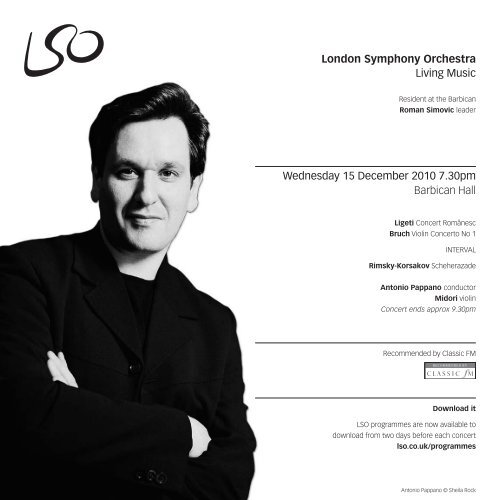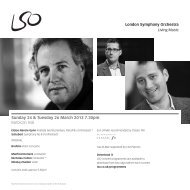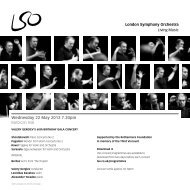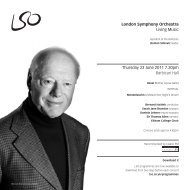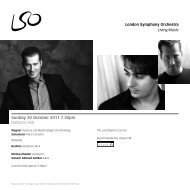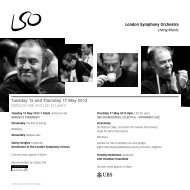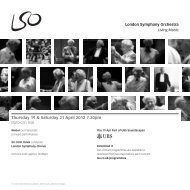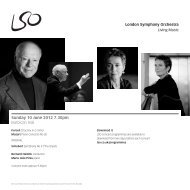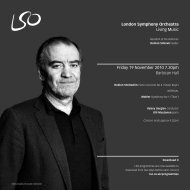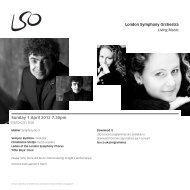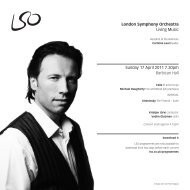15 December programme - London Symphony Orchestra
15 December programme - London Symphony Orchestra
15 December programme - London Symphony Orchestra
Create successful ePaper yourself
Turn your PDF publications into a flip-book with our unique Google optimized e-Paper software.
<strong>London</strong> <strong>Symphony</strong> <strong>Orchestra</strong><br />
Living Music<br />
Resident at the Barbican<br />
Roman Simovic leader<br />
Wednesday <strong>15</strong> <strong>December</strong> 2010 7.30pm<br />
Barbican Hall<br />
Ligeti Concert Românesc<br />
Bruch Violin Concerto No 1<br />
INTERVAL<br />
Rimsky-Korsakov Scheherazade<br />
Antonio Pappano conductor<br />
Midori violin<br />
Concert ends approx 9.30pm<br />
Recommended by Classic FM<br />
Download it<br />
LSO <strong>programme</strong>s are now available to<br />
download from two days before each concert<br />
lso.co.uk/<strong>programme</strong>s<br />
Antonio Pappano © Sheila Rock
Welcome News<br />
Welcome to the second of our winter concerts conducted by Antonio<br />
Pappano. Best known as Musical Director of the Royal Opera House,<br />
Antonio Pappano continues to bring the vitality of the stage to the<br />
LSO with a typically colourful <strong>programme</strong>. Tonight we will hear two<br />
works which showcase the sonority of the violin – Bruch’s Violin<br />
Concerto and Rimsky-Korsakov’s Scheherazade – prefaced by an<br />
early, buoyant work from Ligeti: Concert Românesc.<br />
We are pleased to welcome back Midori as our soloist in the Bruch<br />
Violin Concerto. Midori was the subject of the UBS Soundscapes:<br />
LSO Artist Portrait in 2008 and continues to make her mark through<br />
her performances on the international stage and the work of her<br />
music education foundation.<br />
I would like to take the opportunity to thank our media partner<br />
Classic FM for their continued support of the <strong>Orchestra</strong>’s concert<br />
series at the Barbican.<br />
I wish you all a peaceful Christmas and look forward to seeing you<br />
again early in the New Year.<br />
Kathryn McDowell<br />
LSO Managing Director<br />
2 Welcome & News<br />
LSO Live CDs – the perfect present<br />
If you’re stuck for gift ideas this Christmas, why not treat your nearest<br />
and dearest to the sound of the LSO in their own home? LSO Live is<br />
the best-selling orchestral own-label in the world, offering over 60 top<br />
quality CDs (including special edition box sets) from as little as £5.99.<br />
All CDs are shipped on the same or next working day, guaranteeing<br />
you much-needed wrapping time... Recent releases include Ravel’s<br />
Boléro and Rachmaninov’s <strong>Symphony</strong> No 2. For more details, to<br />
browse the complete catalogue and for special offers, visit:<br />
lso.co.uk/buyrecordings<br />
Join the LSO Friends this Christmas<br />
What does the LSO mean to you? Whatever it is, our Friends mean<br />
everything to us. They recognise our achievements and help us to go<br />
further, from full orchestral Barbican concerts to LSO Discovery<br />
groups for local residents and cross-genre groups with local<br />
teenagers, creating a truly 21st-century orchestra. Membership starts<br />
from just £50; in return, LSO Friends will receive 2011/12 priority<br />
booking as well as a regular behind-the-scenes magazine, chances<br />
to attend open rehearsals, and opportunities to meet LSO musicians<br />
at special events. A great alternative Christmas gift for loved ones –<br />
or keep it for yourself!<br />
lso.co.uk/lsofriends<br />
Music’s better shared!<br />
It pays to bring all your friends, family and work colleagues to<br />
an LSO concert. Groups of 10+ receive a 20% discount on tickets,<br />
plus a host of additional benefits such as free interval coffee and<br />
the chance to meet LSO players. Call the dedicated Group Booking<br />
line on 020 7382 7211 or email groups@barbican.org.uk.<br />
The LSO is delighted to welcome the following groups tonight:<br />
King Edward VI Grammar School, Chelmsford<br />
Gerrards Cross Community Association<br />
Ms Pauline Hawker and Friends<br />
Kathryn McDowell © Camilla Panufnik
György Ligeti (1923–2006)<br />
Concert Românesc (Romanian Concerto) (1951)<br />
1 Andantino<br />
2 Allegro vivace<br />
3 Adagio ma non troppo<br />
4 Molto vivace<br />
It is always tempting to search in a great composer’s earliest works<br />
for signs of the original voice that was about to emerge, and not least<br />
so when the composer in question here, György Ligeti, reckoned that<br />
the essential traits of a musical personality were already in place<br />
by his late teens. Yet while one looks in vain for premonitions of<br />
the avant-garde creator of Atmosphères in what seems more like<br />
a particularly boisterous successor to the Dances of Galanta (1933)<br />
of Ligeti’s mentor Kodály, there was clearly enough radicalism in this<br />
Romanian Concerto to offend Communist authorities: though given<br />
a private rehearsal, it was placed on the banned list.<br />
The musical material here is mainly Romanian folk music that Ligeti<br />
had got to know while transcribing it from perilously fragile wax<br />
cylinders at the Folklore Institute in Bucharest, though there are<br />
some original ‘pseudo-Romanian’ additions of his own. Even with<br />
folk music settings, Ligeti says, only the simplest diatonic and modal<br />
harmonisations were officially sanctioned, so even the mild parallel<br />
fourths and fifths near the start of the lyrical first movement (which<br />
curiously suggest the Hindemith of Mathis rather than Bartók or<br />
Kodály), may already have been beyond the pale.<br />
The short second movement is a rapid dance piece based mainly on<br />
a single, untransposed theme, though a second, even faster theme<br />
puts in a brief appearance after about 30 seconds. This movement<br />
links directly to the third, which begins with a horn solo, echoed by<br />
another horn. Here Ligeti makes use of the ‘natural harmonics’ that<br />
were to fascinate him in later years (but weren’t these, perhaps,<br />
added while revising the work?). Next come two contrasted solos for<br />
cor anglais, and then, almost out of the blue, a huge romantic climax<br />
à la Bluebeard’s Castle, giving way to a series of rising figures in<br />
which folk elements are anything but apparent.<br />
If the second movement was notatably high-spirited, the finale<br />
brings something close to pandemonium. Ligeti recalls how one<br />
New Year during his childhood, ‘Some wild musicians playing violin<br />
and bagpipe forced their way into our courtyard’. And something of<br />
that unbridled, unpredictable wildness is certainly present here. The<br />
tempo is frantic: almost too fast. At first there are just whirling textures<br />
(latent ‘micropolyphony’?), then increasingly frantic violin solos with<br />
boisterous orchestral punctuations. At the end, there is a sudden<br />
‘horn flashback’ (to the third movement), a peremptory bang in the<br />
orchestra, and it’s all over. Could Ligeti really have imagined that the<br />
official censors would sit through all this without batting an eyelid?<br />
It’s a little hard to believe...<br />
Programme note © Richard Toop<br />
Richard Toop is Reader in Music and Chair of the Musicology Unit<br />
at the Sydney Conservatorium (University of Sydney). He has a<br />
particular interest in contemporary art music, most of his work<br />
pertaining to post-war European avant-gardes.<br />
Programme Notes<br />
3
Max Bruch (1838–1920)<br />
Violin Concerto No 1 in G minor Op 26 (1869)<br />
1 Vorspiel – Allegro moderato<br />
2 Adagio<br />
3 Finale – Allegro energico<br />
Midori violin<br />
The first – and by far best-known – of Max Bruch’s three violin<br />
concertos was written for the Hungarian virtuoso Joseph Joachim,<br />
whose charismatic playing inspired similar works from Schumann<br />
and Brahms. In 1868 Joachim became director of the newly-formed<br />
Music Academy in Berlin, where Bruch was a professor, and the next<br />
year Bruch wrote the G minor concerto for his famous colleague.<br />
Although Bruch’s concerto has largely sustained his posthumous<br />
reputation, it suffered for a long time from the musical snobbery<br />
which declared it ‘too easy to be great’. Some of the greatest<br />
concertos – particularly the Brahms and the Tchaikovsky – were<br />
initially damned as hopelessly unviolinistic (usually because their<br />
dedicatees found they couldn’t play them), and only later hailed as<br />
masterpieces. The two exceptions were the Mendelssohn and the<br />
Bruch G minor. Both the Mendelssohn and the Bruch lie brilliantly<br />
under the fingers, so that technical difficulties such as rapid passagework<br />
or double-stopping can be accomplished with relative ease.<br />
The opening movement of the Bruch must have posed problems for<br />
contemporary listeners. Traditionally, a 19th-century concerto begins<br />
with an expansive first movement, usually incorporating a virtuosic<br />
cadenza, giving the soloist a chance to settle into a prolonged and<br />
satisfying battle with the orchestra and to emerge with flying colours.<br />
The first movement of Bruch’s concerto affords the soloist no such<br />
opportunity. It opens not with a bold flourish, but with a fearful,<br />
pianissimo tremolo on the timpani and a plaintive, questioning<br />
statement on wind instruments, to which the soloist replies with an<br />
unaccompanied passage of recitative, earnest and eloquent, but<br />
far from consolatory. The orchestra’s next question coaxes a similar<br />
response, whereupon the question is asked a third time. This time<br />
a more forceful and expansive – but still inconclusive – response is<br />
forthcoming, stated over a muted, restless orchestral background.<br />
Finally, in response to the orchestra’s insistent demands, the soloist<br />
4 Programme Notes<br />
makes a positive statement – a serene, full-blown melody in dialogue<br />
with the orchestra. But the underlying orchestral restlessness returns<br />
to haunt the movement, with the soloist desperately trying to control<br />
the situation with a sequence of ever-blossoming and more agitated<br />
ornamentation. But resolution proves unattainable, and towards the<br />
end the material of the opening recitative returns. The anguished<br />
question of the orchestra remains unanswered, but instead sinks<br />
gently down through a transitional passage onto a despairing<br />
sustained B flat, which magically melts into the E flat radiance of<br />
the Adagio.<br />
Here, questions and answers are redundant. Subtly supported by<br />
the orchestra, the violin simply unfolds one of the most glorious<br />
sustained melodies ever written, exploiting its most luscious timbres<br />
to the full. Mendelssohn’s concerto was an obvious model, and when<br />
Tchaikovsky came to write his Violin Concerto nearly a decade later,<br />
he also recognised the virtue of a simple, lyrical central movement,<br />
eventually settling on the song-like Canzonetta.<br />
But it is the exhilarating, gypsy-style rondo Finale – a clear homage<br />
to its dedicatee’s Hungarian origins – which finally allows the soloist<br />
joyous, uninhibited rein. Brahms coveted this style so much that<br />
when, ten years later, he came to write the finale of his own violin<br />
concerto for Joachim, he borrowed the same effect, so admirably<br />
suited to the instrument. And though Brahms’ colossal masterpiece<br />
has tended to overshadow the more modest, but perhaps more<br />
innovative work by Bruch, a spate of recent recordings by major<br />
violinists has happily restored this underrated gem to its rightful<br />
place in the repertory.<br />
Programme note © Wendy Thompson<br />
Wendy Thompson is Executive Director of Classic Arts Productions,<br />
the major supplier of independent <strong>programme</strong>s to BBC Radio 3,<br />
including Private Passions and Classical Collection.<br />
INTERVAL: 20 minutes
Max Bruch (1838–1920)<br />
Composer Profile<br />
The young Max Bruch was introduced to the rudiments of music by his<br />
mother, a professional soprano and music teacher. His early lessons<br />
were supplemented by studies in music theory with a respected<br />
teacher in Bonn, which enabled the 11-year-old Bruch to compose<br />
an orchestral overture and chamber works. In 1852 he received a<br />
scholarship from the Mozart Foundation in Frankfurt to support studies<br />
in composition and theory with Ferdinand Hiller and piano lessons<br />
in Cologne. His first opera, Scherz, List und Rache, was produced in<br />
Cologne in 1858 and for the next three years he worked there as a<br />
music teacher. After moving to Mannheim in 1862 he met the poet<br />
Geibel and collaborated with him on the three-act opera, Die Loreley.<br />
Bruch served as Music Director from 1865–67 in the German city<br />
of Koblenz. During one of his journeys to Britain, the composer<br />
discovered a copy of James Johnson and Robert Burns’s folk<br />
anthology The Scots Musical Museum. Its tunes offered Bruch<br />
a wealth of ideas that he filtered into his own musical language.<br />
After a period as a freelance composer in Berlin, Bruch succeeded<br />
Julius Benedict as conductor of the Liverpool Philharmonic Society<br />
(1880–83) and thereafter became conductor of the Breslau<br />
Orchesterverein until 1890. He accepted a professorship at the<br />
Berlin Academy in 1890 and taught composition there until he<br />
retired in 1910.<br />
Bruch’s secular choral works, such as Frithjof, the epic Odysseus and<br />
Das Lied von der Glocke, enjoyed considerable popularity during his<br />
lifetime, although today he is best known as a composer of works for<br />
violin and orchestra.<br />
Profile © Andrew Stewart<br />
Community music. World music.<br />
<strong>London</strong> <strong>Symphony</strong> <strong>Orchestra</strong><br />
LSO St Luke’s<br />
Classical music. Everybody’s music.<br />
BBC Radio 3 Lunchtime Concerts<br />
Thursdays 1pm<br />
Mozart Chamber Music<br />
Thu 10 Feb: Christian Blackshaw (piano)<br />
Sonatas in C major K309; C minor K457; Fantasie in D minor K397<br />
Thu 24 Feb: Škampa Quartet<br />
String Quartet in B flat major K458; String Quartet in D major K575<br />
Thu 10 Mar: Elias Quartet with Michael Collins (clarinet)<br />
Clarinet Quintet K581; String Quartet K428<br />
Thu 24 Mar: Vienna Piano Trio<br />
Piano Trios in G major K564; E major K542, B flat major K502<br />
International Violinists<br />
Thu 17 Feb: Alina Ibragimova & Cédric Tiberghien<br />
Ravel & Lekeu<br />
Thu 3 Mar: Daniel Hope & Sebastian Knauer<br />
Brahms, Joachim, Schumann (Clara) & Beethoven<br />
Thu 17 Mar: Patricia Kopatchinskaja & Mihaela Ursuleasa<br />
Beethoven & Enescu<br />
Thu 31 Mar: Janine Jansen & Itamar Golan<br />
Schubert, Messiaen, Dubugnon & Debussy<br />
Tickets £9 (£8 concessions)<br />
For details and to book online visit<br />
lso.co.uk/lsostlukes<br />
or call 020 7638 8891<br />
Programme Notes<br />
5
Nikolai Rimsky-Korsakov (1844–1908)<br />
Scheherazade Op 35 (1888)<br />
1 The Sea and Sinbad’s Ship<br />
2 The Story of Prince Kalender<br />
3 The Young Prince and Princess<br />
4 Festival at Baghdad – The Sea – Shipwreck – Conclusion<br />
Scheherazade was composed at a time when Rimsky-Korsakov was<br />
producing some of his best work for orchestra: he had just finished<br />
the Capriccio Espagnol and would follow Scheherazade with the<br />
Russian Easter Festival Overture. The legends of Old Russia and of<br />
the East had always been the chief inspiration of his music; his first<br />
encounter with Eastern music, at Bakhchisaray in the South Crimea,<br />
left an indelible impression on him.<br />
Scheherazade is based on Arabian Nights, the famous collection<br />
of tales which were supposed to have been told by the Princess<br />
Scheherazade to her husband, the Sultan Shariar. He was accustomed<br />
to putting his wives to death on the morning after the marriage had<br />
been consummated; but on her wedding night, Scheherazade began<br />
telling him a story which so captivated the Sultan that she was able<br />
to prolong it for 1001 nights, at the end of which she had succeeded<br />
in appeasing him. Like some other composers of descriptive<br />
music, Rimsky-Korsakov was anxious not to be too explicit: wishing<br />
Scheherazade to be appreciated in the first place as symphonic music,<br />
he even had the original titles of the movements withdrawn from the<br />
score. Nevertheless, it seems appropriate to give them here. He wrote<br />
in his autobiography: ‘In composing Scheherazade I meant these hints<br />
[the titles] to direct but slightly the hearers’ fancy on the path which<br />
my own fancy had travelled, and to leave more minute and particular<br />
conceptions to the will and mood of each’.<br />
Rimsky-Korsakov also warns against interpreting the themes as<br />
leitmotifs: themes associated with one particular episode may<br />
reappear in quite another context. For instance, the main theme of the<br />
first movement, which one is tempted to call the ‘sea’ motif, is also<br />
used to depict the stern Sultan at the opening of the first and fourth<br />
movements; and when the Princess’ theme in the third movement<br />
turns up again, in very different guise, as the second subject of the<br />
6 Programme Notes<br />
finale, we are not meant to suppose that the Princess is joining in the<br />
festivities at Baghdad.<br />
One theme, however, is definitely a leitmotif: the one played by<br />
the solo violin immediately after the brusque opening. It stands for<br />
Scheherazade herself, and its various appearances throughout the<br />
work, almost always cadenza-like and accompanied only by harp<br />
(though in the first movement it is also cleverly woven into the<br />
orchestral texture), depict her in her role as tireless story-teller.<br />
She introduces three of the movements; she has an intermezzo<br />
to herself in the third; while in the finale, when storm and Sultan<br />
have been calmed, appropriately she has the last word.<br />
Writing of the Capriccio Espagnol in his autobiography, Rimsky-<br />
Korsakov indulged in some understandable self-congratulation<br />
over its orchestration: ‘The opinion formed by both critics and<br />
public, that the Capriccio is a magnificently orchestrated piece – is<br />
wrong. The Capriccio is a brilliant composition for the orchestra.<br />
The change of timbres, the felicitous choice of melodic design and<br />
figuration patterns, exactly suiting each kind of instrument, brief<br />
virtuoso cadenzas for instruments solo, the rhythm of the percussion<br />
instruments, etc, constitute here the very essence of the composition,<br />
and not its garb or orchestration’. These words, strikingly anticipating<br />
the attitude of many 20th-century composers, are also true in every<br />
way of Scheherazade. There have been few composers more capable<br />
than Rimsky-Korsakov of translating their ideas so perfectly into<br />
instrumental sound.<br />
Programme note © David Matthews<br />
David Matthews is a composer and writer. Among his many<br />
orchestral and chamber works are seven symphonies and twelve<br />
string quartets. His Seventh <strong>Symphony</strong> was premiered earlier<br />
this year by the BBC Philharmonic. He has also written studies<br />
of Benjamin Britten and Michael Tippett, and numerous articles<br />
on contemporary music.
Nikolai Rimsky-Korsakov (1844–1908)<br />
Composer Profile<br />
Although music played an important part in the early life of<br />
Rimsky-Korsakov, he followed family tradition and enrolled as a<br />
student at the College of Naval Cadets in St Petersburg in 1856.<br />
He continued to take piano lessons, however, and was introduced<br />
to the influential composer Balakirev and such outstanding young<br />
musicians as Cui and Mussorgsky.<br />
After graduating in 1862 Rimsky-Korsakov joined the crew of the<br />
clipper Almaz and sailed on a voyage that lasted until the summer<br />
of 1865. On his return to St Petersburg, Balakirev encouraged him<br />
to complete the sketches he had made for his First <strong>Symphony</strong>.<br />
Composition increasingly occupied Rimsky-Korsakov’s time, and in<br />
1871 he became a professor of composition at the St Petersburg<br />
Conservatory. He remained on the staff for the rest of his life, with<br />
a brief absence in 1905 when he was censured for supporting<br />
students involved in the rebellion of that year. His Conservatory<br />
and private pupils included Lyadov, Glazunov, Tcherepnin,<br />
Miaskovsky and Stravinsky.<br />
Exotic melodies and orchestrations became a hallmark of<br />
Rimsky-Korsakov’s mature compositions, powerfully so in works<br />
such as the symphonic suite Scheherazade, the operas Mlada,<br />
Tsar Saltan and The Golden Cockerel, and the final version of his<br />
symphonic poem Sadko.<br />
Profile © Andrew Stewart<br />
Thu 3 Feb 8pm<br />
UBS Soundscapes: Eclectica<br />
Sound and Space<br />
Alexander Balanescu violin<br />
Evelina Petrova accordion<br />
Gisele Edwards aerialist<br />
Acclaimed Romanian violinist Alexander Balanescu,<br />
Russian accordionist Evelina Petrova and leading<br />
UK aerialist Gisele Edwards join forces for the first<br />
time in an exciting new commission exploring the<br />
crossover between live music and aerial work in the<br />
evocative space at LSO St Luke’s. This pioneering<br />
new collaboration will sit within an Eastern European<br />
influenced <strong>programme</strong> of music from Alexander and<br />
Evelina’s Upside Down album, which effortlessly<br />
blends Russian folk with jazz improvisation and<br />
classical music.<br />
Tickets £8 £14 £22<br />
lso.co.uk/eclectica<br />
020 7638 8891<br />
<strong>London</strong> <strong>Symphony</strong> <strong>Orchestra</strong><br />
LSO St Luke’s<br />
Programme Notes<br />
7
Antonio Pappano<br />
Conductor<br />
Currently Music Director of the Royal Opera<br />
House, Covent Garden, and the <strong>Orchestra</strong> of<br />
the Accademia Nazionale di Santa Cecilia in<br />
Rome, Antonio Pappano was born in <strong>London</strong><br />
of Italian parents. Aged 13 he moved with<br />
his family to the United States, where he<br />
continued his studies in piano, composition<br />
and conducting. Work as a repetiteur<br />
and assistant conductor rapidly led to his<br />
engagement in theatres throughout the<br />
world: at the New York City Opera, Gran<br />
Teatro del Liceu (Barcelona), Frankfurt Opera,<br />
Lyric Opera of Chicago and the Bayreuth<br />
Festival, where he was assistant to Daniel<br />
Barenboim for Tristan und Isolde, Parsifal and<br />
the Ring Cycle.<br />
In 1987 Pappano made his opera debut with<br />
La bohème at the Norwegian National Opera<br />
and was appointed Music Director there in<br />
1990. During this period, he also made his<br />
conducting debuts at English National Opera,<br />
Covent Garden, San Francisco Opera, Lyric<br />
Opera of Chicago, Théâtre du Châtelet and<br />
Berlin Staatsoper.<br />
8 The Artists<br />
At the age of 32 Pappano was appointed<br />
Music Director of the Théâtre Royal de la<br />
Monnaie and remained in this post for ten<br />
years. In 1993, Pappano made a notable<br />
debut at the Vienna Staatsoper, replacing<br />
Christoph von Dohnànyi at the last minute<br />
in a new production of Wagner’s Siegfried,<br />
for which he received unanimous acclaim.<br />
He made his debut at the Metropolitan<br />
Opera, New York, in 1997 with a new<br />
production of Eugene Onegin and in 1999<br />
at the Bayreuth Festspiele conducting a new<br />
production of Lohengrin. From 1997–99 he<br />
was Principal Guest Conductor of the Israel<br />
Philharmonic <strong>Orchestra</strong>.<br />
Antonio Pappano has also conducted the<br />
Chicago <strong>Symphony</strong> <strong>Orchestra</strong>, Boston<br />
<strong>Symphony</strong> <strong>Orchestra</strong>, Philadelphia <strong>Orchestra</strong>,<br />
the Cleveland <strong>Orchestra</strong>, New York<br />
Philharmonic <strong>Orchestra</strong>, Philharmonia,<br />
Vienna Philharmonic, Munich Philharmonic,<br />
Berlin Philharmonic and Royal<br />
Concertgebouw <strong>Orchestra</strong>.<br />
He has recorded Don Carlos for EMI Classics<br />
(CD and DVD) as well as La bohème,<br />
La Rondine (awarded Best Recording of the<br />
Year by Gramophone magazine), Il Trittico,<br />
Massenet’s Werther and Manon, Madame<br />
Butterfly, Tosca, Il Trovatore, Tristan und<br />
Isolde and the Verdi Requiem. His orchestral<br />
recordings with the Accademia Nazionale<br />
di Santa Cecilia include Tchaikovsky<br />
Symphonies 4, 5 & 6 and Respighi’s<br />
Roman Trilogy, and he has also partnered<br />
Han-Na Chang, Leif Ove Andsnes and<br />
Maxim Vengerov in concerto recordings,<br />
and Ian Bostridge in recital. The Accademia<br />
Nazionale di Santa Cecilia under Pappano won<br />
Critics’ Choice at the Classical BRIT Awards for<br />
their recording of the Verdi Requiem.<br />
He was awarded Artist of the Year 2000 by<br />
Gramophone, the 2003 Olivier Award for<br />
Outstanding Achievement in Opera and the<br />
Royal Philharmonic Society Music Award in<br />
2004. In <strong>December</strong> 2008 Antonio Pappano<br />
was made a Commendatore of the Republic<br />
of Italy. He was recently awarded the Bruno<br />
Walter prize by the Académie du Disque<br />
Lyrique in Paris.<br />
In recent seasons at the Royal Opera<br />
House, Antonio Pappano has conducted the<br />
complete Ring Cycle, the world premiere of<br />
Sir Harrison Birtwistle’s The Minotaur, and<br />
new productions of Tristan und Isolde and<br />
Lulu. This season includes new productions<br />
of Macbeth and the world premiere of a new<br />
opera by Mark-Anthony Turnage.<br />
In future seasons, he will conduct<br />
Parsifal, Il Trittico, Les Vêpres Sicilienne<br />
and The Trojans at Covent Garden, and<br />
will return to conduct concerts with the<br />
Vienna Philharmonic.<br />
Antonio Pappano © Sheila Rock
Midori<br />
Violin<br />
‘The superstar violinist has a<br />
quality that sets her apart:<br />
She listens, and not just to her<br />
fellow musicians but to herself.’<br />
St Petersburg Times<br />
Since her debut at the age of eleven with<br />
the New York Philharmonic over 25 years<br />
ago, the violinist Midori has established a<br />
record of achievement which sets her apart<br />
as a master musician, an innovator and a<br />
champion of the developmental potential of<br />
children. Named a Messenger of Peace by<br />
UN Secretary-General Ban Ki-moon in 2007,<br />
she has created a new model for young<br />
artists who seek to balance the joys and<br />
demands of a performing career at the<br />
highest level with a hands-on investment in<br />
the power of music to change lives.<br />
Midori’s performing schedule is balanced<br />
between recitals, chamber music<br />
performances and appearances with the<br />
world’s most prestigious orchestras.<br />
Midori © Timothy Greenfield-Sanders<br />
Midori’s 2010/11 season will include new<br />
music recitals and workshops, tours of the US,<br />
Europe and Asia, and increasing her already<br />
extensive commitment to music education<br />
in her capacity as Chair of the Strings<br />
Department at the University of Southern<br />
California’s Thornton School of Music.<br />
Among the conductors with whom Midori<br />
will collaborate this season are Christoph<br />
Eschenbach, Donald Runnicles, Alan Gilbert,<br />
Antonio Pappano and Kent Nagano.<br />
In 1992 Midori founded Midori & Friends,<br />
a non-profit organisation in New York which<br />
brings music education <strong>programme</strong>s to<br />
thousands of underprivileged children each<br />
year. Two other organisations, Music Sharing,<br />
based in Japan, and Partners in Performance,<br />
based in the US, also bring music closer to<br />
the lives of people who may not otherwise<br />
have involvement with the arts.<br />
Midori’s commitment to community<br />
collaboration and outreach extends beyond<br />
these organisations to her work with young<br />
violinists in masterclasses all over the world,<br />
and to her <strong>Orchestra</strong> Residencies Programme<br />
in the US. In 2010/11 Midori will conduct<br />
community engagement <strong>programme</strong>s in<br />
Tennessee, New York, Maine, Iowa, Japan,<br />
Bulgaria and Laos.<br />
Midori and violinist Vadim Repin have recently<br />
joined forces for a major commissioning<br />
project; through commissioning organisation<br />
Meet the Composer, individual donors<br />
have commissioned four solo works to be<br />
performed by both violinists as encores in<br />
a variety of contexts, including fundraising<br />
events, media promotion and community<br />
work. Midori and Vadim Repin have chosen<br />
four composers whose work they admire –<br />
Lee Hyla, Rodion Shchedrin, Krzysztof<br />
Penderecki and Derek Bermel.<br />
Midori’s two most recent recordings are an<br />
album of sonatas by J S Bach and Bartók;<br />
and The Essential Midori, a 2-CD compilation<br />
(both released on Sony Masterworks).<br />
Midori was born in Osaka in 1971 and began<br />
studying the violin with her mother at an<br />
early age. She lives in Los Angeles and plays<br />
a 1734 Guarnerius del Gesu ex-Huberman,<br />
which is on lifetime loan to her from the<br />
Hayashibara Foundation.<br />
The Artists<br />
9
‘Sibelius’ Violin<br />
Concerto is one of<br />
my favourite pieces;<br />
it’s something<br />
I grew up with.<br />
Working with Julia Fischer<br />
is a lot of fun. She’s quite<br />
a violinist, and quite a<br />
character. Everything<br />
seems so natural between<br />
us, there’s a lot of give and take. In the<br />
Sibelius Violin Concerto that’s paramount.’<br />
Kristjan Järvi on conducting Sibelius<br />
alongside violinist Julia Fischer with the LSO<br />
<strong>London</strong> <strong>Symphony</strong> <strong>Orchestra</strong><br />
Living Music<br />
Violin Concertos with the LSO<br />
Spring/Summer 2011<br />
Tue 18 & Sun 23 Jan: Sergey Khachatryan<br />
Shostakovich Violin Concerto No 2<br />
Thu 17 Feb: Janine Jansen<br />
Brahms Violin Concerto<br />
Wed 23 & Thu 24 Mar: Leonidas Kavakos<br />
Shostakovich Violin Concerto No 1<br />
Sun 3 Apr: Leila Josefowicz<br />
Prokofiev Violin Concerto No 1<br />
Thu 7 Apr: Julia Fischer<br />
Sibelius Violin Concerto<br />
Sun 17 Apr: Vadim Gluzman<br />
Michael Daugherty Fire and Blood<br />
Resident at the Barbican<br />
lso.co.uk (reduced bkg fee)<br />
020 7638 8891 (bkg fee)<br />
Photo © Gautier Deblonde
On stage<br />
First Violins<br />
Roman Simovic Leader<br />
Tomo Keller<br />
Nicholas Wright<br />
Nigel Broadbent<br />
Ginette Decuyper<br />
Jörg Hammann<br />
Michael Humphrey<br />
Maxine Kwok-Adams<br />
Claire Parfitt<br />
Elizabeth Pigram<br />
Laurent Quenelle<br />
Harriet Rayfield<br />
Colin Renwick<br />
Ian Rhodes<br />
Sylvain Vasseur<br />
Rhys Watkins<br />
Second Violins<br />
Evgeny Grach<br />
Thomas Norris<br />
Sarah Quinn<br />
Miya Ichinose<br />
Richard Blayden<br />
Matthew Gardner<br />
Belinda McFarlane<br />
Iwona Muszynska<br />
Philip Nolte<br />
Andrew Pollock<br />
Paul Robson<br />
Louise Shackelton<br />
Erzsebet Racz<br />
Violaine Delmas<br />
Violas<br />
Paul Silverthorne<br />
Malcolm Johnston<br />
German Clavijo<br />
Lander Echevarria<br />
Richard Holttum<br />
Robert Turner<br />
Jonathan Welch<br />
Ellen Blythe<br />
Nancy Johnson<br />
Caroline O’Neill<br />
Fiona Opie<br />
Anna Dorothea Vogel<br />
Cellos<br />
Timothy Hugh<br />
Jennifer Brown<br />
Mary Bergin<br />
Noel Bradshaw<br />
Daniel Gardner<br />
Keith Glossop<br />
Hilary Jones<br />
Minat Lyons<br />
Amanda Truelove<br />
Judith Herbert<br />
Double Basses<br />
Rinat Ibragimov<br />
Colin Paris<br />
Nicholas Worters<br />
Patrick Laurence<br />
Matthew Gibson<br />
Thomas Goodman<br />
Jani Pensola<br />
Simo Vaisanen<br />
Flutes<br />
Gareth Davies<br />
Siobhan Grealy<br />
Sharon Williams<br />
Oboes<br />
Jerome Guichard<br />
John Lawley<br />
Cor Anglais<br />
Christine Pendrill<br />
Clarinets<br />
Chris Richards<br />
Chi-Yu Mo<br />
Bassoons<br />
Bernardo Verde<br />
Joost Bosdijk<br />
Horns<br />
Timothy Jones<br />
Angela Barnes<br />
Jonathan Lipton<br />
Jeffrey Bryant<br />
Antonio Geremia Iezzi<br />
Trumpets<br />
Roderick Franks<br />
Gerald Ruddock<br />
Nigel Gomm<br />
Trombones<br />
Katy Jones<br />
James Maynard<br />
Bass Trombone<br />
Paul Milner<br />
Tuba<br />
Patrick Harrild<br />
Timpani<br />
Antoine Bedewi<br />
Percussion<br />
Sam Walton<br />
David Jackson<br />
Adam Clifford<br />
Sacha Johnson<br />
Glyn Matthews<br />
Harp<br />
Karen Vaughan<br />
LSO String<br />
Experience Scheme<br />
Established in 1992, the<br />
LSO String Experience<br />
Scheme enables young string<br />
players at the start of their<br />
professional careers to gain<br />
work experience by playing in<br />
rehearsals and concerts with<br />
the LSO. The scheme auditions<br />
students from the <strong>London</strong><br />
music conservatoires, and 20<br />
students per year are selected<br />
to participate. The musicians<br />
are treated as professional<br />
’extra’ players (additional to<br />
LSO members) and receive<br />
fees for their work in line with<br />
LSO section players. Students<br />
of wind, brass or percussion<br />
instruments who are in their<br />
final year or on a postgraduate<br />
course at one of the <strong>London</strong><br />
conservatoires can also<br />
benefit from training with LSO<br />
musicians in a similar scheme.<br />
Aki Sawa (first violin), Stephanie<br />
Edmundson (viola), Mark<br />
Lindley (cello) and Ha-Young<br />
Jung (double bass) took part in<br />
rehearsals for tonight’s concert<br />
as part of the LSO String<br />
Experience Scheme.<br />
The LSO String Experience<br />
Scheme is generously<br />
supported by the Musicians<br />
Benevolent Fund and Charles<br />
and Pascale Clark.<br />
List correct at time of<br />
going to press<br />
See page xv for <strong>London</strong><br />
<strong>Symphony</strong> <strong>Orchestra</strong> members<br />
Editor Edward Appleyard<br />
edward.appleyard@lso.co.uk<br />
Print<br />
Cantate 020 7622 3401<br />
Advertising<br />
Cabbell Ltd 020 8971 8450<br />
The <strong>Orchestra</strong><br />
11
Inbox<br />
Your thoughts and comments about recent performances<br />
We were really enchanted by the<br />
orchestra. Mahler was wonderful,<br />
we enjoyed the excellent<br />
performance. It was worth the<br />
trip from Belgium!<br />
19 Nov 2010, Valery Gergiev &<br />
Olli Mustonen / Rodion Shchedrin<br />
Piano Concerto No 4 & Mahler<br />
<strong>Symphony</strong> No 1<br />
12 Inbox<br />
‘Worth the trip!’<br />
Françoise Holvoet<br />
‘They deserve praise’<br />
Peter Ludbrook<br />
This was a terrific concert.<br />
I’ve been fairly critical of some<br />
of the other new pieces<br />
introduced under the UBS<br />
Soundscapes project but I was<br />
enthralled by Emily Howard’s<br />
Solar, which gripped from its<br />
riveting opening bars.<br />
The Elgar Violin Concerto was<br />
wonderful. I don’t think I’ve<br />
ever heard a dud performance<br />
but this was special. Playing it<br />
on the violin Kreisler used at<br />
its premiere did give it an extra<br />
frisson. Nikolaj Znaider, Sir Colin<br />
and the LSO deserve the highest<br />
praise for a great performance of<br />
a great work.<br />
10 Nov 2010, Sir Colin Davis &<br />
Nikolaj Znaider / Elgar Violin<br />
Concerto & Mendelssohn<br />
<strong>Symphony</strong> No 3<br />
‘Quite wonderful’<br />
David Foulger<br />
A quite wonderful performance<br />
of the Elgar Violin Concerto.<br />
Znaider was if anything a little<br />
freer with portamenti and rubato<br />
than on his recording. I loved the<br />
way he kept turning to members<br />
of the orchestra to integrate their<br />
phrasing with his.<br />
10 Nov 2010, Sir Colin Davis &<br />
Nikolaj Znaider / Elgar Violin<br />
Concerto & Mendelssohn<br />
<strong>Symphony</strong> No 3<br />
Want to share your views?<br />
Email us at comment@lso.co.uk<br />
Let us know what you think.<br />
We’d love to hear more from you<br />
on all aspects of the LSO’s work.<br />
Please note that the LSO may edit your<br />
comments and not all emails will be published.<br />
From Facebook and Twitter...<br />
This is such an engaging piece<br />
of writing. Love the image of you<br />
all leaping off the train like<br />
bowler-hatted workers from<br />
the Bank of England.<br />
Ben Pendrey [LSO Tour Blog]<br />
Loved your concerts in JAPAN!<br />
I went twice!!!<br />
June Makiguchi Higami<br />
Keep up the amazing work –<br />
LSO Live is an accomplishment you<br />
can be very proud of.<br />
ejwolf08


